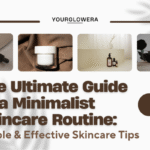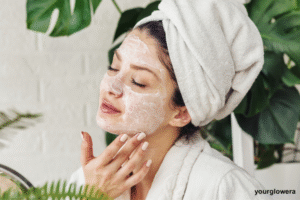Combination skin can be tricky to care for, but with the best skincare routine for combination skin, you can achieve a glowing complexion without all the frustration.
This type of skin tends to be oily in some areas, like the T-zone (forehead, nose, and chin), while other areas like the cheeks might be dry. Balancing these contrasting needs requires a thoughtful skincare routine tailored to this unique skin type.
So, how do you take care of combination skin without compromising on hydration or getting overwhelmed by excess oil?
Let’s dive into the best skincare routine for combination skin, including affordable, effective products that won’t break the bank.
This guide will help you discover the best advice and help you choose the best budget-friendly products to care for your skin, so you can flaunt a healthy and glowing complexion every day!
Table of Contents
1. Understand Your Skin Type: Why It Matters
Know Your Skin’s Needs
When it comes to the best skincare routine for combination skin, understanding your skin is key. Combination skin can vary significantly from one person to another.
Some individuals may experience an oily T-zone with dry cheeks, while others might have the opposite. Identifying how your skin behaves throughout the day and seasonally is crucial for selecting the right products.
Skin Sensitivity and Product Selection
Because combination skin has both oily and dry zones, it’s important to choose products that address both concerns without irritating your skin.
Select products labeled as “gentle” or “suitable for sensitive skin” to help minimize the risk of irritation or worsening of skin conditions.
The Right Routine for Combination Skin
The best skincare routine for combination skin balances hydration, oil control, and gentle cleansing. A bit of trial and error will help you discover what works best for your skin!
2. Cleansing: A Critical First Step
Choose the Right Cleanser for Combination Skin
Cleansing is the foundation of any skincare routine, especially when your skin is combination. A gentle, sulfate-free cleanser that doesn’t strip your skin’s natural oils is ideal.
You don’t want to over-dry the dry patches or leave too much oil on the oily zones.
Double Cleansing: Is It Necessary?
For some, double cleansing can be beneficial. If you wear makeup or sunscreen daily, you may find that using an oil-based cleanser first, followed by a water-based one, ensures you remove all impurities without drying your skin.
How Often to Cleanse
Over-cleansing can irritate combination skin, so it’s best to stick to cleansing twice a day: once in the morning to remove overnight oils and once at night to remove dirt, oil, and makeup.
3. Exfoliate: Clear Your Pores Without Overdoing It
The Benefits of Exfoliation for Combination Skin
Exfoliating helps remove dead skin cells and unclogs pores, especially in the oily areas. However, you need to be careful not to over-exfoliate, which can lead to irritation and imbalance. Usually, applying treatments once or twice a week is enough.
Best Exfoliants for Combination Skin
Look for exfoliants that contain both chemical exfoliants like AHAs or BHAs and physical exfoliants with gentle scrub particles. These can help tackle oil buildup while also softening dry areas.
Avoid Harsh Scrubs
While physical exfoliants are tempting, avoid harsh scrubs with large, rough particles, as they can create microtears on your skin, causing more harm than good.

4. Toning: Restoring pH Balance
Why Toner is Essential for Combination Skin
Toners help restore the skin’s pH balance after cleansing, leaving your skin refreshed and prepared for the next steps in your skincare routine.
They help ensure that your skin isn’t too dry or too oily after washing, which is especially important for combination skin. A good toner will tighten pores, remove excess oil, and prepare your skin for the next steps in your skincare routine.
Alcohol-Free Toners Are a Must
One of the main mistakes people with combination skin make is choosing toners that contain alcohol. Alcohol can be overly harsh on both the dry and oily areas of your face.
It strips your skin of its natural moisture, leading to more oil production in the T-zone and exacerbating dryness in the cheek area. Instead, opt for alcohol-free toners, which are soothing and more effective for balancing the skin.
How to Apply Toner
Toner should be applied after cleansing but before applying any serums or moisturizers. You can use a cotton pad to gently apply toner to your face, or alternatively, you can pour a few drops onto your palms and pat it directly onto your skin, making it an important step in the best skincare routine for combination skin.
Focus on your T-zone and areas where your pores tend to be more noticeable. Make sure to allow the toner to absorb fully before proceeding to the next step in your routine.
5. Serums: Target Specific Concerns
The Role of Serums: Why They Are a Must-Have in Your Skincare Routine
Serums are highly concentrated formulations designed to address specific skin concerns, such as oil control, acne prevention, or hydration.
They are formulated with active ingredients that penetrate deeply into the skin, making them an essential part of the best skincare routine for combination skin.
For combination skin, you can use serums that target specific problem areas, like oiliness or dryness, to create a customized approach to skincare.
Best Ingredients for Combination Skin
There are a few key ingredients that work wonders for combination skin. For instance, hyaluronic acid helps to draw moisture into the skin without making it greasy, making it an ideal ingredient for drier areas, and an excellent addition to the best skincare routine for combination skin.
Niacinamide is another great ingredient because it controls oil production in the T-zone while also soothing and calming inflammation. Vitamin C is another powerful antioxidant that brightens the skin, evens out skin tone, and helps with hyperpigmentation.
How to Layer Your Serums
It’s important to apply serums in the correct order when layering them. Generally, you should start with the thinnest, most lightweight serum first.
Apply lighter, water-based serums before moving to thicker, oil-based serums. Allow each layer a few minutes to absorb before applying the next, ensuring the active ingredients work effectively as part of the best skincare routine for combination skin.
6. Moisturizing: Hydrate Without the Shine
Importance of Moisturizing for Combination Skin
Moisturizing is a crucial step for combination skin, even if you already have an oily T-zone. Staying hydrated helps maintain your skin’s health, smoothness, and balance.
Without proper hydration, your skin may overcompensate by producing more oil, which can result in breakouts and clogged pores. On the other hand, applying a moisturizer that is too rich may worsen the oiliness in your T-zone.
Best Moisturizers for Combination Skin
When choosing a moisturizer, opt for lightweight, oil-free options. Gel-based moisturizers are often ideal because they hydrate without feeling heavy or greasy, making them perfect for the best skincare routine for combination skin.
You can also use a moisturizer that has a matte finish to help reduce shine in the T-zone while still nourishing the dry areas of your face.
How to Apply Moisturizer
Apply a thin, even layer of moisturizer all over your face. If you feel the need, you can use a slightly thicker moisturizer on the areas that feel drier (usually the cheeks), and a lighter layer on your T-zone.
Make sure to apply moisturizer in gentle, upward motions to avoid tugging on the skin.
7. Sunscreen: Don’t Skip This Step!
Why Sunscreen is Non-Negotiable
Including sunscreen in your skincare routine is essential. UV rays from the sun can damage your skin, causing premature aging, dark spots, and even skin cancer.
Even if you have combination skin, it’s important to wear sunscreen every day to shield your skin from damaging sun rays, making it an essential step in the best skincare routine for combination skin.
Sunscreen Options for Combination Skin
Look for lightweight, broad-spectrum sunscreens that offer protection against both UVA and UVB rays. Mineral sunscreens with zinc oxide or titanium dioxide tend to be gentler on the skin and provide an added benefit for those with sensitive areas.
Gel-based or oil-free formulas are ideal for combination skin, as they won’t leave you feeling greasy or cause breakouts.
How to Apply Sunscreen
You should apply sunscreen as the last step in your morning skincare routine, following your moisturizer. Make sure to apply a generous amount to your entire face and neck.
Remember to reapply sunscreen every two hours, particularly when you’re outdoors. Even if it’s cloudy or you’re staying indoors, UV rays can still penetrate windows, so it’s essential to protect your skin at all times as part of the best skincare routine for combination skin.
8. Night Care: Repair and Renew
Nighttime Skincare for Combination Skin
Your skin has the chance to repair itself while you sleep at night. During the day, your skin faces environmental stressors such as pollution, UV exposure, and makeup, which is why a nighttime routine is crucial in the best skincare routine for combination skin.
At night, the skin goes into repair mode, making it an essential time to apply products that help it heal, restore moisture, and rebuild its barrier.
Overnight Masks for Extra Hydration
You can use overnight masks to help restore moisture to dry areas while ensuring the oily areas are properly balanced. Look for hydrating masks that provide deep nourishment, such as those containing hyaluronic acid, aloe vera, or glycerin.
These ingredients help keep your skin hydrated while preventing it from feeling greasy, making them perfect for the best skincare routine for combination skin.
How to Properly Care for Your Skin at Night
Night time is an ideal opportunity to focus on restoration and renewal of your skin. Applying serums first allows active ingredients to penetrate deeply, followed by a rich moisturizer to lock in hydration.
If your skin feels especially dry, using a heavier cream on the cheeks and a lighter moisturizer on the T-zone can help balance hydration and oiliness for a healthier, more refreshed complexion.
9. Incorporating Masks: Boost Your Routine
Clay Masks for Oily Areas
Clay masks effectively help control oil and are especially beneficial for individuals with combination skin. Clay helps to absorb excess oil, unclog pores, and leave your T-zone feeling clean and refreshed, making it a great addition to the best skincare routine for combination skin.
Use these once a week to deeply cleanse your skin without irritating the dry areas.
Hydrating Masks for Dry Areas
For dry patches on your skin, incorporate hydrating masks into your routine. Ingredients like honey, aloe vera, or cucumber extract can soothe and replenish moisture in the dry zones of your face.
A hydrating mask once a week can make a noticeable difference.
How to Use Masks in Your Routine
Begin by cleansing your face, then apply the mask to the areas that need it. If you’re using a clay mask for the oily T-zone and a hydrating mask for your cheeks, apply the clay mask first, rinse it off, and follow up with the hydrating mask.
10. The Best Budget-Friendly Products for Combination Skin
Affordable Options for Cleansing
Cleansing doesn’t need to be expensive, especially when you can find affordable products that work well for combination skin.
Look for gentle, sulfate-free cleansers at your local drugstore that offer balance and hydration. These products often perform just as well as high-end options, making them a great choice for the best skincare routine for combination skin.
Budget Serums and Moisturizers
While some serums and moisturizers can be pricey, many affordable brands offer excellent formulations. Look for drugstore serums with ingredients like hyaluronic acid, niacinamide, or retinol, which work wonders for combination skin.
Select a lightweight, non-comedogenic moisturizer that provides hydration without blocking your pores.
Affordable Sunscreens You’ll Love
Don’t spend a fortune on sunscreen when there are budget-friendly options available. Many drugstore sunscreens are oil-free, lightweight, and offer broad-spectrum protection.
Choose sunscreens that are specifically labeled for combination or sensitive skin types.

11. Adjusting Your Routine Seasonally
Skin Changes with the Seasons
As the weather changes, so does your skin. During the colder months, your skin might become drier, while in the summer, it may produce more oil.
Adjust your skincare routine to address these seasonal changes and keep your skin balanced throughout the year, ensuring the best skincare routine for combination skin.
Switching Up Products
In the winter, you may want to swap your lightweight moisturizer for something thicker and more hydrating.
Conversely, in the summer, you might want to switch to a gel-based moisturizer or a mattifying lotion to control excess oil. Similarly, your sunscreen formula may need to change depending on the season.
How to Transition Between Seasons
When transitioning between seasons, introduce new products gradually to avoid irritating your skin.
Start by adding one new product at a time and observe how your skin reacts before making additional changes. This approach will help you maintain an effective best skincare routine for combination skin throughout the year.
12. The Importance of Consistency
Stick to Your Routine
One of the keys to achieving great skin is consistency. The best skincare routine for combination skin is one that you follow consistently, day and night.
Results may take time, but with regular use, you’ll begin to notice improvements in your skin’s appearance.
Avoid Switching Products Too Often
While it’s tempting to try every new product that hits the market, it’s essential to stick to your skincare routine long enough to see the effects.
Regularly switching skincare products can cause unpredictable skin reactions and potentially exacerbate existing problems. It’s important to be patient and allow your products enough time to show results.
Listen to Your Skin
As you go through your skincare journey, it’s important to pay attention to how your skin feels and reacts. If something doesn’t work, don’t be afraid to make changes.
Your skin is unique, so what works for someone else may not necessarily be effective for you, especially when finding the best skincare routine for combination skin.
13. Common Mistakes to Avoid
Over-Exfoliating
Exfoliating is essential to remove dead skin cells, but doing it too frequently can cause irritation, sensitivity, and imbalance.
Exfoliate only once or twice a week, based on your skin’s needs, to prevent damaging its natural barrier.
Using Harsh Products
Harsh, stripping products can worsen both oily and dry areas of your face. Avoid products with harsh alcohol or fragrances that might irritate your skin, especially when following the best skincare routine for combination skin.
Instead, choose products that are gentle, hydrating, and calming in formulation.
Ignoring Sunscreen
It can be easy to forget sunscreen, especially when it’s cloudy or you’re staying indoors. But UV rays can still cause skin damage even when you can’t see the sun.
Make sure to apply sunscreen every morning, even when you’re not directly exposed to sunlight.
14. Professional Treatments for Combination Skin
When to Seek Professional Help
If you feel like your skincare routine isn’t working as well as it should, it might be time to seek professional help to optimize your best skincare routine for combination skin.
Consulting a dermatologist can help analyze your skin and recommend the most suitable products or treatments tailored to your skin type and specific concerns.
Professional Peels and Facials
Chemical peels and facials can be highly beneficial for those with combination skin. They help exfoliate the skin, clear clogged pores, and target both oily and dry areas.
Consult with a professional to determine which treatments are right for you.
Regular Skin Checkups
Even if you have a solid at-home skincare routine, regular checkups with a dermatologist can help ensure that you’re on the right track, especially when maintaining the best skincare routine for combination skin.
They can provide advice on managing your skin’s condition and help you stay on top of any emerging skin issues.

15. Final Thoughts: Achieving Healthy, Glowing Skin
When it comes to caring for combination skin, balance is key.
The best skincare routine for combination skin includes gentle cleansing, targeted treatments for oily and dry areas, and regular hydration and sun protection.
By choosing the right products and being consistent with your routine, you can enjoy healthy, balanced skin that looks and feels great.
For those struggling with combination skin, discovering the right skincare routine is key. Check out our blog post on the “Best Skincare Routine for Combination Skin: A straightforward method for nourishment and regulation“.
In this post, we offer practical tips that will help you nourish and regulate your skin, ensuring it stays healthy and radiant. Don’t miss these easy steps to achieving the perfect balance for your skin in the best skincare routine for combination skin!
Frequently Asked Questions
1. Can I do skincare twice?
Yes, doing skincare twice a day—once in the morning and once at night—is highly recommended. Morning skincare focuses on protection and hydration, while nighttime skincare is for cleansing and repairing the skin, making it an essential part of the best skincare routine for combination skin.
2. What is the Korean skin method?
The Korean skin method involves a multi-step skincare routine with an emphasis on hydration, gentle exfoliation, and layering of lightweight products such as toners, essences, serums, and moisturizers. It promotes healthy, glowing skin through careful and consistent skincare practices, making it a great approach for the best skincare routine for combination skin.
3. How to clear skin overnight with the best skincare routine for combination skin?
To clear skin overnight, use a gentle exfoliant to remove dead skin, followed by a hydrating serum (with ingredients like hyaluronic acid). Apply a moisturizer and, if necessary, an overnight mask to lock in moisture and help soothe the skin as you sleep, making it a great addition to the best skincare routine for combination skin.
4. Is toner necessary for the best skincare routine for combination skin?
Yes, toner is an essential part of skincare, especially for combination skin. It helps balance the skin’s pH after cleansing, remove leftover impurities, and prepare the skin to better absorb moisturizers and serums, making it a key step in the best skincare routine for combination skin.
5. What is the No. 1 brand recommended by dermatologists for the best skincare routine for combination skin?
Some of the most recommended skincare brands by dermatologists for all skin types, including combination skin, are CeraVe, La Roche-Posay, and Neutrogena. These brands are known for their gentle and effective formulations, making them perfect for the best skincare routine for combination skin.









Leave a reply